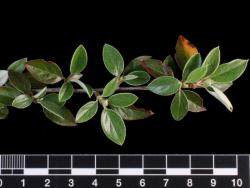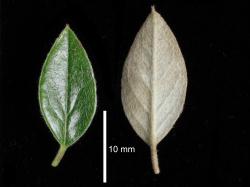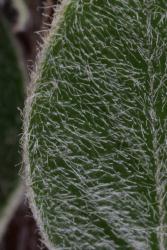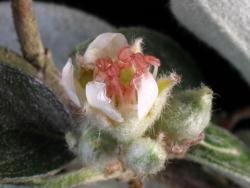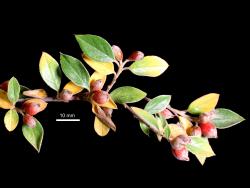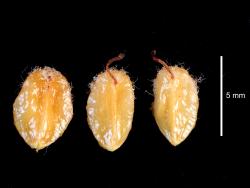Erect shrub c. 1 m tall, semi-deciduous (many leaves yellowing by May), branchlets red-brown, with peeling cuticle, lenticels sparse. Branchlet hairs dense, white to pale yellow, semi-strigose. Stipules 2.5 mm long, red, densely hairy with white hairs. Leaves crowded, elliptical to slightly ovate, plane to slightly V-shaped, 22–25 mm long, lamina 17–20 mm long, 9.5–10.0 mm wide, petiole 5 mm long, petiole hairs dense, pale yellow; leaf base cuneate; leaf apex acute with a straight apiculus; lateral veins in 3–4 pairs, midvein and base of lateral veins impressed on upper surface and projecting on lower surface, upper leaf surface smooth, dark yellowish-green, young leaves pale due to upper-surface hairs, old leaves glossy after hairs have gone; upper surfaces of young leaves with moderately dense, white, straight, fine hairs; old leaves glabrous on upper surface; leaf margins plane, with hairs dense, white; lower surface with very dense, white, woolly hairs, becoming dirty on old leaves.
Inflorescence in corymbs of 4–8 flowers, with fascicles of 4 leaves, corymb 18–27 mm long, rachis hairs dense, white, woolly. Flowers sessile (hypanthium long-tapering) at flowering, pedicel after flowering 1–4 mm long, 5.3–6.0 mm diameter when open. Hypanthium hairs dense, white, woolly; sepals 2.0–2.5 mm long, 2.1–2.3 mm wide, green, erect, hairs dense, white, woolly. Petals pink in bud, when open erect, white, sometimes tinged with pink, 2.9–4.5 mm long, 2.7–2.8 mm wide, petal margins entire or irregular, lacking a hair tuft. Stamens 19–20, filaments 1.8–2.5 mm long, white; anthers dark pink, 0.8–0.9 mm long. Styles 2–3, c. 2.0 mm long. Fruit vivid reddish-orange (RHS 42A), ovoid, 8.0–9.0 mm long, including calyx, 5.9–6.0 mm diameter, calyx closed, the skin with dense, white, woolly hairs. Pyrenes invariably 3 per fruit, 4.2–5.1 mm long, 2.8–3.5 mm wide, hairs sparse, umbonate, style attached c. 1.0 mm below apex.
A synonym of Cotoneaster franchetii according to Lu & Brach (2003) and a synonym of C. pannosus according to Dickoré & Kasperek (2010). Recognised as a species by Fryer & Hylmö (2009), who say the petals are "semispreading to erect" and "off-white with small pink dots". Their description has it somewhat intermediate between C. franchetii and C. pannosus.
Recognition by the white petals that are erect and longer than wide, 2–3 styles per flower and 2–3 pyrenes per fruit, with the style having its origin well below the pyrene apex. The leaves are elliptical and c. 25 mm long. The upper leaf surface has moderately dense woolly hairs, which are lost with age. The lower leaf surface has dense, white, woolly hairs that completely obscure the lower leaf surface, which has a felted appearance. The felted surface becomes dirty with age. There are only 4–8 flowers per inflorescence. Two distinctive features of C. amoenus fruit are that the calyx projects, giving the fruit an ellipsoidal shape, and the fruit tends to be densely hairy.
Most similar to Cotoneaster franchetii in leaf shape and leaf hairs; the flowers have erect petals, and the fruit have similar pyrenes, 2–3, and the style is attached well below the apex. The leaves of C. amoenus are smaller, 22–25 × 10 mm rather than 30–42 × 13–22 mm. The flowers of C. amoenus have petals that are white with pink tinging on parts exposed when in bud, not dark pink to red centrally and pink on the margins. The fruit are smaller than those of C. franchetii: 5.9–6.0 mm in diameter rather than 7.0–9.6 mm in diameter.
Also very similar in appearance to Cotoneaster pannosus. The leaves are similar in shape and hair distribution to those of C. pannosus but are smaller, 22–25 × 10 mm rather than 27–48 × 11–19 mm long. Cotoneaster amoenus has 2–3 styles per flower and pyrenes per fruit, while C. pannosus invariably has 2. Cotoneaster amoenus has the style originating from the inner face of the pyrene rather than from its apex, as in C. pannosus.
Similar to Cotoneaster dielsianus in leaf size and dense hairs on the underside of the leaf. Cotoneaster dielsianus has been cultivated in New Zealand in the past, e.g., Eastwoodhill (1966) and Christchurch City (1987), but is not currently known to be present. Cotoneaster amoenus is evergreen while C. dielsianus is deciduous. Cotoneaster amoenus has white, spreading petals while C. dielsianus has erect petals that are red centrally with a paler border. Cotoneaster amoenus has 3 styles/pyrenes, whereas C. dielsianus has (3)4(5) per flower or fruit.
Present in Dunedin Botanic Gardens (2014–2015) as a single plant, and in Abberley Park, Christchurch (2016), as a single plant. Eastwoodhill Arboretum, W.R. Sykes, 23 Oct. 1968, CHR 186265. Not listed in New Zealand horticultural trade catalogues.
Flowering: December; Fruiting: April onwards
Tetraploid (Fryer & Hylmö 2009, p. 242), confirmed by flow cytometry using CHR 638084.



